#filmmaking at its finest
Text

Lo que es esta maravilla, por favor.
#filmmaking at its finest#mi dato favorito hasta ahora#ahhhhhhhhhhhhh#La Sociedad de la Nieve#J.A. Bayona#NUNCA voy a perdonarle a Netflix que hiciera campaña fuerte por el bodrio de Maestro#cuando esta obra de arte estaba ALLÍ#luego llegó Maestro llevándose un montón de nominaciones inmerecidas y ellos (Netflix) quieren que nos conformemos#con las migajas que dejan los demás por su ridículo marketing horrible
8 notes
·
View notes
Text
Oh my god, season 2 is The Tales of Crowley Hoffmann
I guess this has to be a series now too. Part 1 l Part 2
When Aziraphale wants to perform a show-stopping magic trick in S2E4, he is shown the "Professor's Nightmare," a rope trick, and references "Prof Hoff himself" at the end of the minisode.
Because we love double meanings so much around here, I decided to actually watch the Powell & Pressburger epic opera film "The Tales of Hoffmann," assuming it was the another P&P easter egg and the other Hoffmann (not the magician) that was being referenced.
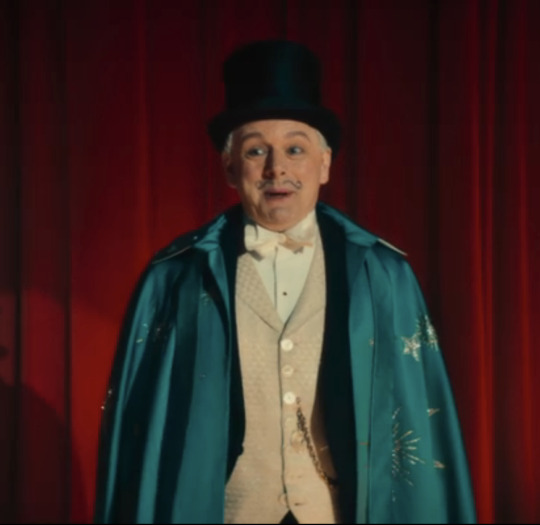
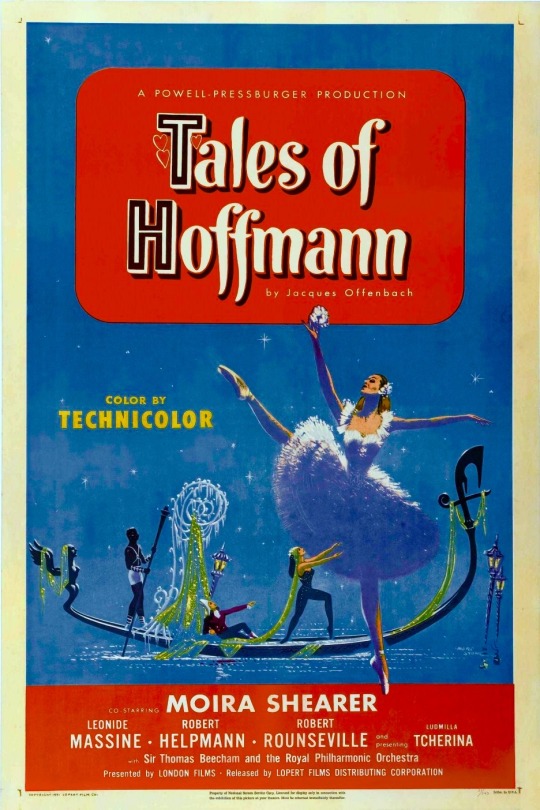
One, this movie is unhinged. Two, this season IS The Tales of Hoffmann. Allow me to explain...
There are shot for shot quotes literally everywhere throughout the season.
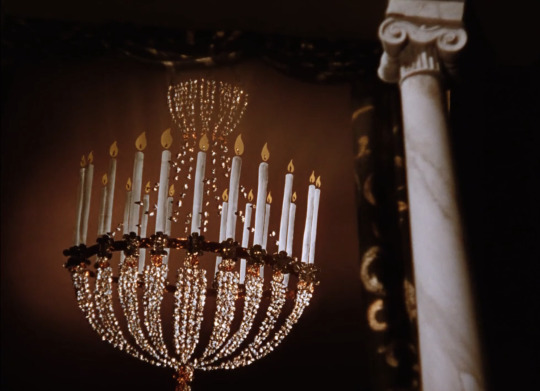

P&P The Tales of Hoffmann (Automaton Ball) & Good Omens Season 2 "The Ball"

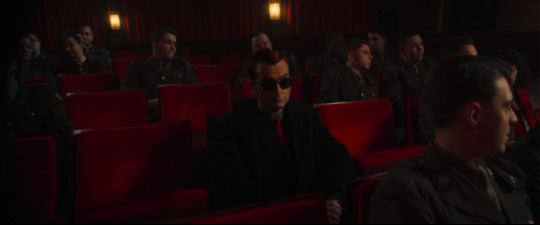
P&P The Tales of Hoffmann (Hoffmann watches Stella perform) & Good Omens Season 2 "The one with the zombies"
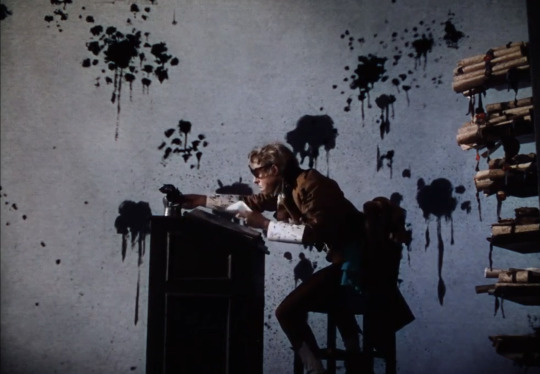

P&P The Tales of Hoffmann (Clerk in Automaton Ball) & Good Omens Season 2 "The Ball"
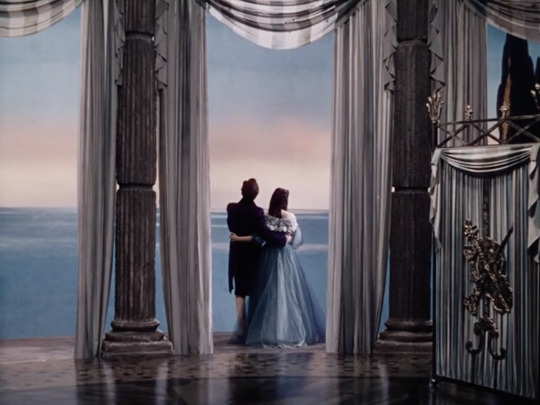

P&P The Tales of Hoffmann (Tale of Antonia, Hoffman & Antonia) & Good Omens Season 2 "The Clue Crowley & Aziraphale"

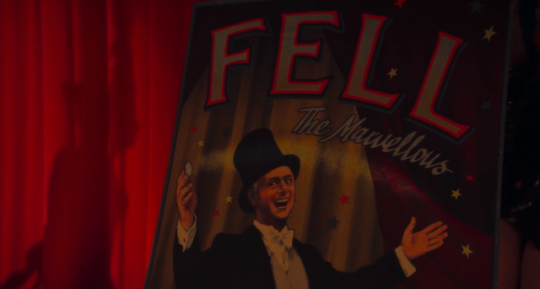
P&P The Tales of Hoffmann (Prologue) & Good Omens Season 2 "The one with the Zombies"
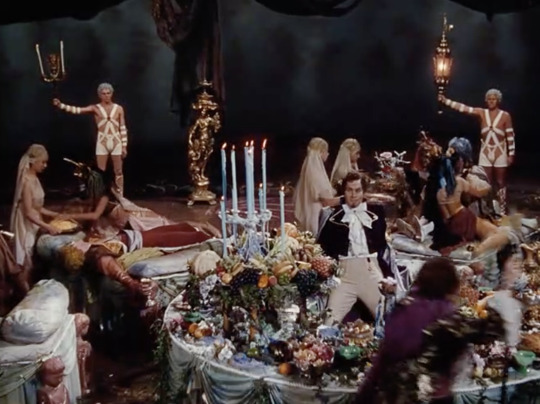

P&P The Tales of Hoffmann (Tale of Giulietta Banquet scene) & Good Omens Season 2 "The Clue Banquet scene"
*By the way Hoffmann wears a goatee for this tale

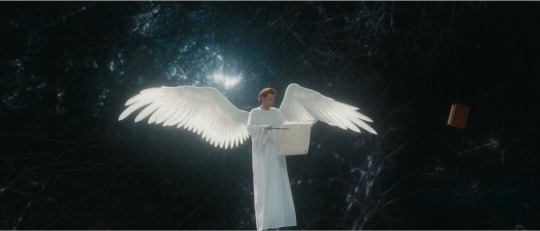
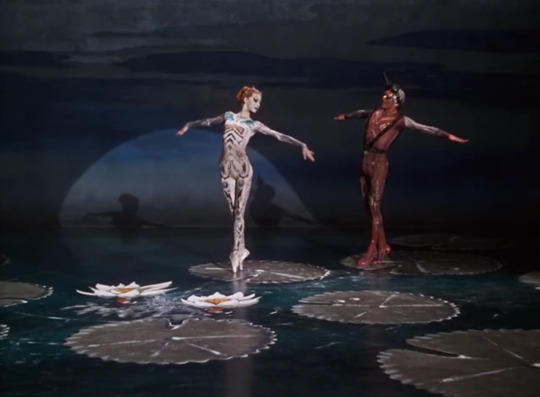
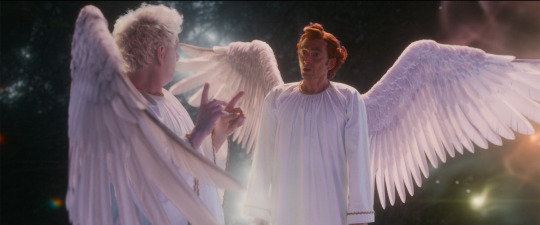
P&P The Tales of Hoffmann (Prologue "Dragonfly dance") & Good Omens Season 2 Prologue "Before the Beginning"
*This is Stella and un unknown devil drangonfly, NOT Hoffmann
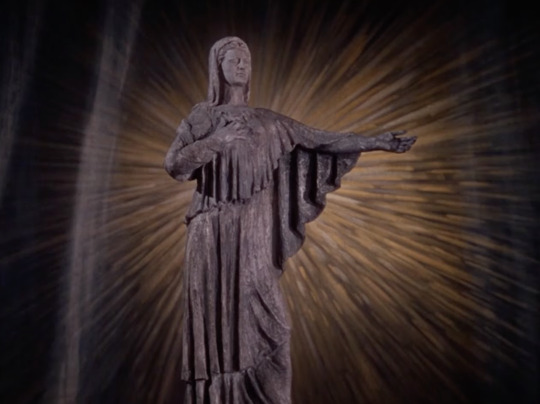
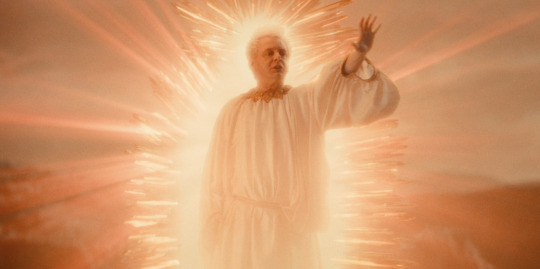
P&P The Tales of Hoffmann (Tale of Antonia) & Good Omens Season 2 "The Clue"


P&P The Tales of Hoffmann (Tale of Antonia) & Good Omens Season 2 "The one with the Zombies"


P&P The Tales of Hoffmann (Automaton Ball) & Good Omens Season 2 "The Ball"

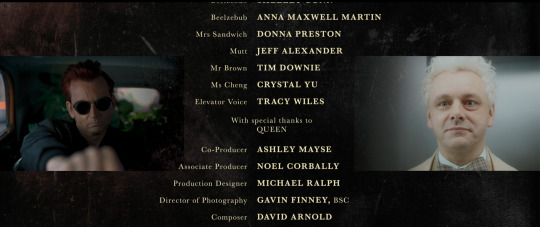
P&P The Tales of Hoffmann (End credits through Hoffman's glasses) & Good Omens Season 2 end credit scene.

Stella & Aziraphale. This one makes me laugh.
There are SO MANY MORE, but tumblr has an image limit. Seriously, it's nuts.
2. It seems simple and straightforward, but it's not at all
" Why would ambitious filmmakers simply film an opera? Many admirers of the work of Michael Powell and Emeric Pressburger have assumed that their decision to make The Tales of Hoffmann (...) was in some way an admission(...) that they couldn’t go on making their edgy, over-the-top melodramas after the rejection and interference they’d suffered (but) there’s a case for considering The Tales of Hoffmann as one of the finest and boldest works that Powell and Pressburger produced, so far ahead of its time as a wholly “composed” film, combining visual and musical elements, that it has still not been fully appreciated... Late in his life, Powell himself said that he thought it was one of the best films that he and Pressburger had made.
What makes the film so remarkable is a series of paradoxes: the fact that it virtually reinvented the freedom and fantasy of silent cinema while making full use of Technicolor and a stellar cast of dancers and singers..." - Criterion, The lives of marionettes
3. The structure of the story is the same as the show
Here is the story of the Movie** (Not really the Opera that inspired it)
In the prologue, we see the dance of the dragonflies onstage at a ballet.
Count Lindoff (very bad dude) is spying on both the principal dancer Stella, and the audience member Hoffmann (who's admiring her). Lindoff is behind the scenery. During her dance, Stella passes a love note to her assistant for Hoffmann. The bad dude intercepts it out of jealousy. During the intermission, Hoffmann goes down to the tavern next door, watched by his sort of buddy in red, Nicklaus. People ask him to tell stories to while away the time, and so he tells 3 stories (actually four but we'll get back to that).
We launch into 3 tales/minisodes in other times and places :
1. The Tale of the Ball of the Automaton where he falls in love with a robot. He is humiliated.
2. The tale of Venice (Giulietta) where he falls in love with a courtesan/double agent who crosses him.
3. The tale of Antonia, where he falls in love with a girl who feels trapped by her living dad, her dead mom and a mysterious bad dude (Lindoff). She is murdered in a ring of fire, but becomes a ghost and is resurrected and sent back to earth.
At the end, we snap back to the tavern in the real world. Hoffmann reveals that these three women are all metaphors for how he feels about Stella, his true love. He's drunk and depressed now, thinking she never sent for him after the show. Stella arrives in the tavern looking for Hoffmann, ready to run away, but now accompanied by Lindoff (dressed as an angelic figure) who followed her. She looks to Hoffmann to save her, but he's too blinded by the fact that he doesn't think she loves him back to pick up on the signal. He gives up, and she goes back up the stairs guided by Lindoff. Her assistant (who was bribed by Lindoff at the beginning) is given the go ahead by Lindoff to go back to the tavern and taker over. They close the door to the tavern, while she walks up ethereal stairs with the bad dude. THE END.
The one story that doesn't fit into the minisodes and is told in the real world is Kleinzach. We understand by the end of this one that this is Hoffmann's self loathing about never being good enough for Stella, because Stella is perfect and Hoffmann is ugly and deformed. The main love interest attempts to steal Kleinzach's essence through a mirror by the end.
4. Powell & Pressburger recast four actors in new roles
In The Tales of Hoffmann, P&P decided to recast four of the principal actors/dancers from the film The Red Shoes in new roles, wanting to recreate the magic that they brought to the first ballet film. Sound familiar?
5. Crowley is Hoffmann

"The Tales of Hoffmann" original 1881 costume concept for Hoffmann & Crowley costume sketch for S2E3 1827 Edinburgh.
Glasses are a really important aspect for Hoffmann in both the opera and the movie versions of The Tales of Hoffmann. Hoffmann is gifted metaphorical magic glasses that he wears to be able to perceive his love in a way they aren't really in real life. In the opera, he wears dark glasses to shut out the real world, not just as a metaphor. Check out a modern day version of the opera's Hoffmann costume :
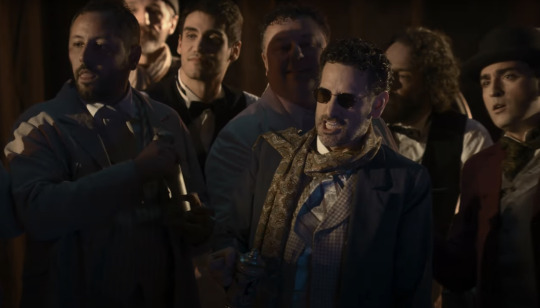
He's french and slamming a beer but you get it.
Crowley also canonically loves watching movies. It would make so much sense that his minisode recountings with him and Aziraphale would resemble different styles of movie that he loves. Seeing as we see him drive away at the end as the last character, an argument could be made for him being the ultimate narrator of the story in season 2.
6. The original American release of The Tales of Hoffman had 14ish minutes cut out of it by the studio.
So we all know by now that whole debacle about having the clocks jump 14-15ish minutes during the kiss?
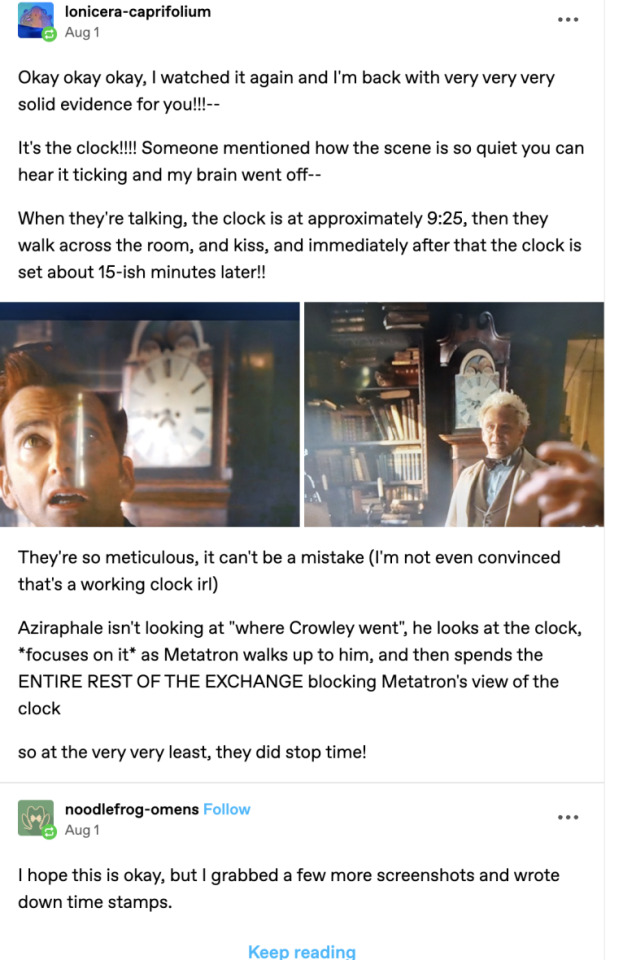
"The Tales of Hoffmann found an audience far wider than expected, despite Korda’s misgivings about the movie’s running time and his decision to cut 14 minutes out of the film for its American release." - Criterion, The Tales of Hoffman
I have been unable to unearth what the difference between the American & British versions of the P&P Tales of Hoffmann is, if you know let ME know. I want to know!
_____________________________________
And I HAVE SO MUCH MORE. This is long enough already so I'll save the more detailed stuff for a new post.
**The opera is a whole other beast. You can read about it here, but basically there's a lot more going on in the opera because the composer died before finishing it, and multiple versions exist after the original uncompleted score got lost IN A FIRE. Anyway.
Here's part 2
#good omens meta#good omens season two#art director talks good omens#go season 2#good omens 2#go meta#good omens season 2#go2#crowley x aziraphale#anthony j crowley#aziraphale and crowley#aziraphale x crowley#crowley and aziraphale
510 notes
·
View notes
Note
After seeing ADC’s birthmark now I can’t get the idea of a Clexa Overboard AU out of my head 😭 The gay urge to queer-ify every straight movie I’ve ever seen and make it about a little blonde bitch and a slightly less little brunette bitch 🥴 Brainrot at its finest
Ok here's my problem. Objectively!!???? Overboard was a terrible movie 😩 not the movie itself on a surface level. The movie itself was entertaining and amazing and a classic. But the plot??? The pLOT??
Dude lied to her, gaslit her, took her and turned her into his maid/nanny. He neglected her and talked to her like shit, degraded, humiliated, and demeaned her repeatedly (often in front of people, to his own glee), and then had sex with her while she didn't have all of her mental faculties. And then had audacity to be genuinely hurt when she was mad and left when she found out. I know they painted it as though she could overlook all that for ~true love~ and that she, whew, that she learned the errors of her ways of being mean to him (I could write a dissertation on what the filmmakers were saying here 😒) but uhhhhhhh being a rude and shitty employer is nOt the same as kidnapping, borderline slavery, and basically sexual assault. I mean he made this woman believe she had children and made her feel like a bad mother for his lazy ass parenting. HE HAD SEX WITH HER WHEN SHE DIDN'T EVEN ACTUALLY KNOW HER OWN NAME FFS. I just

Believe me I've thought this movie through for clexafication because I do like the movie and have watched it a bunch of times, but I just... idk how I could adjust it realistically so it excludes all that awful shit 🥴
#bisexualseraphim#I'm still with you tho that if anyone should've been in the remake it should've been her cuz I mean come ON#with that birthmark? wasted opportunity
15 notes
·
View notes
Text
'Cillian Murphy quite literally wandered into acting. At the age of 20, he walked up to the door of the Corcadorca Theatre Company in his hometown of Cork, Ireland, and knocked. He told the person who answered that he’d be interested in getting involved in any upcoming shows, and the man suggested he try out for a new play called “Disco Pigs,” about a pair of reckless teenagers. It was Murphy’s first audition, and he got the part.
The Enda Walsh play was a big success, moving to larger and larger theaters and eventually leading to a film adaptation in 2001 from director Kirsten Sheridan. That film caught the eye of filmmaker Danny Boyle, then looking to cast a fresh face for his post-apocalyptic thriller “28 Days Later.”
The rest is history — or history in the making as, 20 years later, Murphy is continuing to seek out bold projects with some of the best filmmakers working today. That includes Christopher Nolan, who first brought Murphy to supervillain stardom in “Batman Begins” and who directs the actor in the titular role in “Oppenheimer,” now in theaters. It’s their sixth collaboration, and Murphy’s biggest role yet, playing the complex physicist and “father of the atomic bomb” over a course of several years and a three-hour runtime. It’s one of Murphy’s finest performances, which is saying a lot.
There isn’t a genre or a medium the actor has shied away from over the years. And while some films might not always work as a whole, Murphy always shines. He’s also a true actor’s actor, one who understands every role is integral and is comfortable taking on supporting parts. Here’s a look at 10 of his best performances from his career on stage, film and television.
10. 28 Days Later (2002)

This is how most of the world was introduced to Murphy — a pair of impossibly blue eyes fill the screen as his character, a bicycle courier named Jim, awakes from a coma in Danny Boyle’s heralded action epic. He’s been asleep less than a month, but a lot can happen in that time — including the complete collapse of society thanks to a virus called “Rage” that turns its victims into mindless aggressors. (Note that the Z-word is never uttered throughout the film.) It’s a star-making turn for Murphy, only 24 at the time, who not only carries the film but holds his own against such impressive cast members as Brendan Gleeson and Naomie Harris as fellow survivors. Jim is discovering everything at the same time as the viewer, and Murphy makes the perfect audience surrogate, taking everything in with a suitably shocked but level-headed demeanor. He’s not a traditional action hero, and that’s the point: He’s just an ordinary man trying to navigate an entirely new world.
9. Batman Begins (2005)
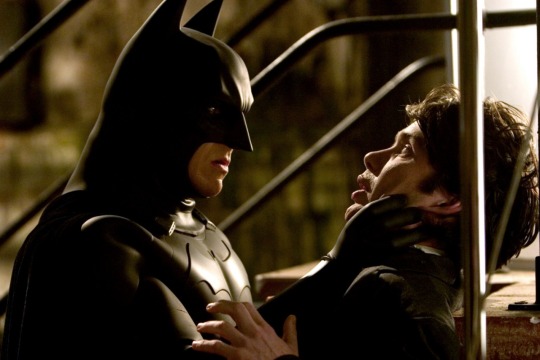
Prior to Christopher Nolan’s Dark Knight trilogy, films adapted from comics were a largely uplifting affair full of primary colors and bright locations. It’s easy to forget how much had to go right for “Batman Begins” to succeed, but it started with finding a villain who was as compelling as his nemesis. Though Murphy originally tested for Bruce Wayne/Batman, it was a stroke of genius that Nolan would peg him as Dr. Jonathan Crane, aka Scarecrow. With a charisma that can be both terrifying and seductive (which would become a Murphy speciality in years to come) Crane doesn’t need to showboat he’s the bad guy. Rather, he exudes a calm confidence, taking his time with methodical precision. Even the way he says the word “Batman,” drawing it out into two separate words, is chilling. It was wise of Nolan to include Scarecrow in the film’s two sequels — particularly in “The Dark Knight Rises,” where he pops up as a judge in a kangaroo courtroom with a smirk (“Exile or death?”) that shows he’s enjoying this almost as much as the audience is.
8. Red Eye (2005)
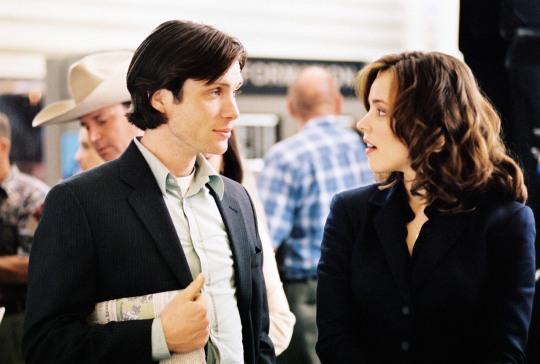
It would be easy to dismiss Wes Craven’s tight thriller — largely set onboard a red-eye flight in which a terrorist threatens a fellow passenger in order to pull off an assassination plot at the hotel she manages — because it’s so damn fun. But it’s also a clever, lean thriller buoyed by two actors toward the beginning of their film careers. Murphy is the perhaps too-aptly named Jackson Rippner while Rachel McAdams is his victim, Lisa Reisert. Part of the brilliance of Carl Ellsworth’s script is how the first few minutes play like a rom-com; two impossibly good-looking people meet cute at the airport and sparks immediately fly. Murphy understands that Rippner can’t telegraph evil — this is a man chosen for the assignment because he has deep resources of charm. They engage in a cat-and-mouse game throughout the flight that is so charged, don’t be surprised if there’s a part of you wondering if these two crazy kids can work it out.
7. Breakfast on Pluto (2005)
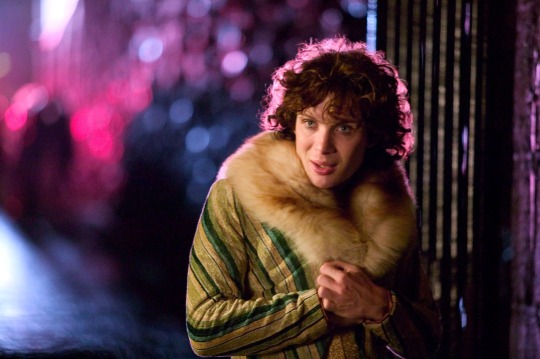
From the beginning of his film career, Murphy refused to be pigeonholed, seeking out unique projects and interesting roles without much of a concern for box office results. The same year he made his supervillain debut in “Batman Begins,” he pivoted by playing Kitten, the transgender heroine searching for love and her birth mother in Neil Jordan’s adaptation of Pat McCabe’s novel. While the casting of a cis man in the role might raise issues today, Murphy’s portrayal is a loving homage to the tenacity and tenderness of the character. Kitten is charming and determined, and Murphy finds a joy in her life even when things take a dark turn. It’s also a chance for Murphy to reunite with some of his previous co-stars, including Gleeson, Stephen Rea and Liam Neeson – forming a powerhouse of Irish performers.
6. Disco Pigs (2001)

Murphy’s feature film debut is an adaptation of the Enda Walsh play in which he made his theatrical (and acting) debut. Murphy stars as “Pig” and Elaine Cassidy is “Runt,” a pair of teenagers who have been devoted to one another since birth. Pig is all raging id, completely unpredictable and prone to violent outbursts. But Murphy also shows his deep vulnerability and affection for his friend, particularly as their relationship begins to shift away from purely platonic. It’s a stunning debut, and Murphy’s raw talent and potential are on full display. So much so that the film caught the eye of an up-and-coming director named Danny Boyle, who would go on to cast Murphy in his breakout “28 Days Later” role.
5. The Wind that Shakes the Barley (2006)

Ken Loach is such a perfect fit for Murphy, it’s a shame the two haven’t collaborated on another film since this tale of two war-torn brothers during the Irish War of Independence. Murphy is Damien, a doctor who initially wants no part of the fighting, resigned to the idea that the war is unwinnable. But after witnessing several injustices, he impulsively joins the Irish Republican Army. Murphy portrays the transformation into a radicalized soldier who ultimately sacrifices everything for his cause without ever hitting a false note. It’s a heartbreaking, emotional journey that grounds the film, which went on to win the Palme d’Or at the 2006 Cannes Film Festival and is regarded by many as Loach’s best.
4. Peaky Blinders (2013-2022)

Murphy has always been drawn to the written word, no matter the medium. So after headlining films from the likes of Danny Boyle and Neil Jordan, he made a point to return to the stage and had no qualms about signing up for a television series penned by acclaimed writer Steven Knight (“Dirty Pretty Things,” “Eastern Promises”). The actor is a perfect fit in Knight’s universe of morally compromised men you can’t take your eyes off of. His Tommy Shelby is a war veteran turned leader of the Peaky Blinders criminal organization. His work is all pragmatism: He’s often stoic as he manipulates and calculates. But he’s also haunted — both by what he’s seen in the war and by his deep and abiding love for his late wife Grace. Of course, Murphy is so magnetic, fans of the show often have to be reminded that he is actually a villain. Put aside the mass murder and corruption — I’m still not over him shooting that horse.
3. Oppenheimer (2023)

After five collaborations with Nolan, the filmmaker finally let Murphy take the lead — and it was worth waiting for. Murphy portrays the rise and fall of J. Robert Oppenheimer, the theoretical physicist known as the creator of the atomic bomb. Murphy ricochets through time, portraying Oppenheimer in his young adulthood as a fragile student, his glory heading The Manhattan Project and his later years where he’s fighting the government that once heralded him. These three timelines are usually easy to distinguish from one another, but sometimes they flow together with no obvious way to differentiate –yet Murphy is always precisely where he needs to be. Though Oppenheimer is a mass of contradictions — he can be controlled yet irrational, naïve yet arrogant — he always makes sense through Murphy’s interpretation. He is particularly haunting playing Oppenheimer in his later years: Both physically and spiritually, you feel like you’re watching a man fading away before your eyes.
2. Misterman (2011)
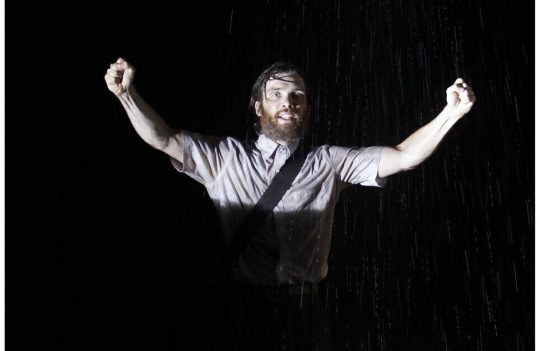
For this tour-de-force, Murphy went back to where it all began – not only the theater but specifically a play by Enda Walsh, whose “Disco Pigs” set Murphy on his journey as an actor. He plays Thomas Magill (never “Tom”) a loner and fanatic on a mission to cleanse his small Irish town of its sins. Murphy is the only actor on stage for the duration of the play, but this is not a staid affair — he literally bounces off the walls, hurls objects and races back and forth — all as he builds his story to a powerful crescendo. It’s exhausting just to watch, and yet you won’t be able to look away. While Murphy performed the role on several stages, it was also filmed as part of National Theatre at Home series for Landmark Productions, who show it on occasion. Keep an eye out, as it’s not one to be missed.
1. Inception (2010)
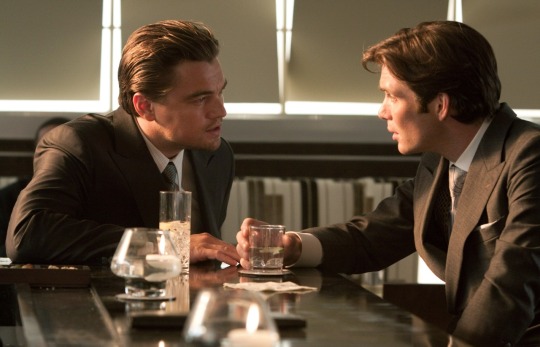
When citing Murphy’s collaborations with Nolan, it would make sense to favor “Dunkirk,” in which he offers a harrowing depiction of PTSD as a traumatized solider; or “Oppenheimer,” in which he occupies nearly every frame as the star of the film. But for me, Murphy is the lynchpin in one of Nolan’s best, most ambitious and most emotional masterpieces, the byzantine thriller “Inception.” He plays Robert Michael Fischer, the heir to a business empire whose unresolved daddy issues make him the target of a team of “extractors.” Led by Leonardo DiCaprio’s Dom Cobb, the thieves use dream technology to infiltrate the subconscious of a target to access information. Fischer is a man of few words and Murphy is fantastic at quietly communicating his pain and making you care for a character that is, in many ways, intended to be a cipher. Murphy shows that “best” doesn’t need to mean “most” — both in terms of the size of the role and the acting, delivering a sublime supporting performance that the entire movie rests on. Nolan is often accused (wrongly) of being a cold filmmaker. But the moment where Fischer finds closure with his late father is perhaps the most affecting gut-punch he’s ever delivered, thanks largely to Murphy’s beautiful performance.'
#Cillian Murphy#Christopher Nolan#Ken Loach#Enda Walsh#Disco Pigs#Danny Boyle#Corcadorca Theatre Company#Oppenheimer#The Wind That Shakes The Barley#Misterman#Inception#Breakfast on Pluto#28 Days Later#Leonardo DiCaprio#Peaky Blinders#Tommy Shelby#Steven Knight#Dirty Pretty Things#Eastern Promises#National Theatre at Home#Palme d'Or#Cannes#Red Eye#Rachel McAdams#Wes Craven#Batman Begins#Dr. Jonathan Crane#Scarecrow#Brendan Gleeson#Liam Neeson
24 notes
·
View notes
Text
Recently Viewed: Godzilla Minus One
[The following review contains MINOR SPOILERS; YOU HAVE BEEN WARNED!]
In Godzilla Minus One, the eponymous prehistoric reptile is largely metaphorical, symbolizing Japan’s postwar trauma and the fragility of its newfound peace. The figurative nature of the monster is, of course, typical of the franchise; here, however, the creature’s thematic significance is clearer and more elegantly conveyed than ever before (with the possible exception of its original appearance in 1954).

The story is, after all, set in the immediate aftermath of World War II, with the characters struggling to rebuild their lives amidst the scorched rubble of Tokyo. The protagonist—a former kamikaze pilot haunted by the specters of his slain comrades and tormented by the shame of his own "dishonorable" survival—is just one of many lost souls inhabiting a city that has been reduced to a Stygian wasteland. Quite against his will, he soon finds himself in the company of fellow outcasts: a stubbornly optimistic young woman and the orphaned infant that she rescued from the wreckage of an air raid shelter. Despite his initial reservations, the three gradually develop a familial bond—a pantomime of “normalcy” and domestic bliss. Unfortunately, our tortured hero feels too inherently unworthy of happiness to formalize the makeshift “marriage”; in his darkest moments, he even suspects that his companions might be mere figments of his imagination—hallucinations conjured by his delirious subconscious as he slowly bleeds to death in a muddy ditch. Thus, from his perspective, Godzilla’s arrival feels particularly karmic—but is it divine punishment for his “cowardice” during his suicide mission… or a miraculous opportunity for “redemption?”
These internal and interpersonal conflicts enrich the drama and raise the narrative stakes, keeping the audience emotionally invested in the chaotic action and anchoring the already impressive special effects. Indeed, director Takashi Yamazaki delivers spectacle and substance in equal measure—the best of both worlds. His vision of Godzilla revolves around devastation and ruin, but ultimately emphasizes the indomitable perseverance of the human spirit.

And this tonal and stylistic versatility—the filmmakers’ remarkable ability to deftly and seamlessly transition between horror, adventure, despair, catharsis, and sheer awe—distinguishes Godzilla Minus One as one of the finest kaiju movies ever produced.
#Godzilla Minus One#Godzilla#Takashi Yamazaki#Toho#kaiju#kaiju eiga#Japanese film#Japanese cinema#film#writing#movie review
13 notes
·
View notes
Text
The Price May Be Right - Number 15
Welcome to “The Price May Be Right!” I’m counting down My Top 31 Favorite Vincent Price Performances & Appearances! The countdown will cover movies, TV productions, and many more forms of media.
We’ve reached the Top 15 for this countdown! Today we focus on Number 15: Richelieu, from The Three Musketeers.

Alexandre Dumas’ classic swashbuckling stories of “The Three Musketeers” have been adapted numerous times to the stage and screen. When it comes to movie adaptations, most people agree that the best version is the 1970s Musketeers Trilogy, directed by Richard Lester. However, if there is a cinematic runner-up to the Lester Trilogy of Musketeer movies for the best adaptation, it is undoubtedly the 1948 film from MGM, directed by George Sidney. This Technicolor adventure epic does a most excellent job of telling the rather broad story from Dumas’ novel, condensing the plot down to a length of just over two hours without sacrificing much in the way of characters and intrigue. It also features some of the finest performances ever done by its star-studded cast, including Gene Kelly as the heroic D’Artagnan, Angela Lansbury as Queen Anne, Frank Morgan as King Louis XIII, Lana Turner as Milady De Winter…and Vincent Price as the main villain of the story, Richelieu.
In the original book, Richelieu is, of course, Cardinal Richelieu: a controversial historical figure. While most adaptations keep this fact in play, most likely because he WAS a real person, the 1948 film takes liberties with history by making Richelieu the Prime Minister of France. The reason for this was simply the world of filmmaking at the time: there was trepidation about depicting a leading figure of the Catholic Church as the villain of the story in the 1940s, due to religious sympathies and a fear of censorship. While Vincent’s Richelieu may not have the title of Cardinal, this ultimately matters little, since the fictional character of Richelieu remains basically intact. And in works like this, that is what counts most.
In many ways, I like to say Richelieu is a Bond Villain who existed before Bond Villains were even a thing. I mean, first of all, just look at the image I chose: that’s basically the Archetypal Bond Villain Pose, courtesy of Blofeld. XD But even in terms of the plot and the role he plays in the story, this character feels like the sort of evil genius a protagonist like 007 would have needed to tackle. He’s a cunning puppet master of a villain; the kind of evil mastermind who lurks in the shadows, pulling the strings. Richelieu does little in terms of direct confrontation with his adversaries, but instead prefers to use his henchmen and the power he has over the state and military to enforce his will. He makes loyal subjects seem like traitors, and hires serial murderers as his lieutenants, all while plotting to take over the kingdom entirely and wage war against his enemies in England. The funniest part is, at the end of the story, Richelieu doesn’t TECHNICALLY lose: while his plans are foiled, his defeat comes at a high cost for the heroes, which makes the ending interesting in its tone. In some ways it’s a happy ending, but in other ways there’s a sort of ambiguity to it.
Vincent’s performance is both hammy and understated at the same time. He plays Richelieu with a Satanical charm and equally devilish eloquency. His character is a smarmy, crafty villain, and a master strategist: he seems to know just about everything about his enemies, and even his allies, and is able to out-think them and be two steps ahead at almost every turn. Whenever one scheme fails, he has a backup plan already set up. Anytime D’Artagnan and the other Musketeers think they’ve got Richelieu all figured out, he throws them a curveball that makes them second guess their whole approach. While he never rants or raves, or laughs beyond a chortle, his oily performance definitely carries a thick layer of melodrama to it in the way it is written and framed. There are also elements of empathy to Richelieu, as there are lines even he hesitates to cross in his work, and he can be reasoned with under certain circumstances. He even shows a sense of respect towards his opponents; always a fun quality in an antagonist. This is another role I don’t hear people talk about too often when they discuss Price’s best characters, but it’s definitely worthy of a place in my personal Top 15.
Tomorrow, the countdown continues with Number 14!
#the price may be right#top 31 vincent price performances#list#countdown#best#favorites#vincent price#movies#film#literature#the three musketeers#richelieu#number 15#alexandre dumas#gene kelly#actors#acting
21 notes
·
View notes
Text
2023 Best Picture Nominees Ranked From Worst to Best
A late list from us at Reel, but a interesting night with some suprising winners meant plenty of time to reflect and discuss, eagerly anticipating the slate of films this year.
Whether or not you agree with the awards it’s safe to say that this year’s nominees for Best Picture were an eclectic group of films all bringing something different to the table. From franchise epics to dark comedies, from war films to music biopics, you cannot deny the quality on show. But, even though all the films were individualistic, some were better than others. Here is our ranking of the Best Picture Nominees from worst to best.
10. Avatar: Way of the Water

Most of the naysayers of James Cameron’s epic Sci-Fi sequel have been silenced as the film became the 3rd highest grossing film of all time. Absolutely nothing can take away the huge financial success of Cameron’s 3-hour water adventure, but, for all the vast landscapes, exciting action and visual wonder it offers, the film still gets bogged down by what plagued it’s predecessor.
For all its otherworldly qualities the film’s biggest problem is in its humanity. The multitude of characters, and their stories, feel like mere splashes in the ocean Cameron has created for us. While the visuals deservedly won big on Oscar night, there really isn’t enough consistency in Avatar’s vast 3-hour runtime, making the journey feel like a slog more so than the thrill-ride everyone was promised.
9. Triangle of Sadness

Ruben Ostlund’s third feature had early signs it may follow a similar trajectory to the one Parasite had 4 years ago. Winning the Palme D’Or and getting nominated for a number of other awards across the globe, it looked like Ostlund would be celebrating deep into award season for his film. However, with no wins at this year’s Academy Awards, Triangle of Sadness has faded into the darkness as far superior films took the spotlight. This may just be circumstantial but arguably it’s because, despite being captivating in parts, this is Ostlund’s weakest effort.
When compared to The Square and Force Majeure, both of which have an enigmatic quality to their stories, Triangle of Sadness regularly smacks you on the head with its themes. Even when Ostlund is showing us some of the finest direction of the year (particularly in the dinner scene on the boat), it still gets dragged out to the extreme – hitting home ideas that were already communicated 10 minutes before. Having said that, Ostlund remains one of the most interesting filmmakers working today and despite Triangle of Sadness feeling weaker than his other efforts, there are still moments of brilliance scattered throughout.
8. The Fabelmans

The biggest takeaway from Spielberg’s reflective life story is that the Director has never lost his touch. Sure, some of his more recent ventures pale in comparison to Schindler’s List, Jurassic Park and Jaws, but his understanding of the medium and how audiences connect to it are the shining light in The Fabelmans. Scenes in which Sammy Fabelman watches his audience react to his films are wonderfully constructed, making it clear that the legendary director has never lost his love for cinema.
However, this film was always going to border on the self indulgent. If you compare this film to the reflective efforts of Cuarón’s Roma and Brannagh’s Belfast, The Fabelmans struggles to find a core reason to tell its story. Its backdrop dabbles with elements of depression, anti-semitism and bullying but never fully explores them and while Spielberg is telling the story with his heart on his sleeve, it still can’t find a genuine reason for the story it’s telling.
7. Top Gun: Maverick

One of the year’s biggest surprises was the quality on show in David Kosinsky’s sequel to the cheesy 80’s classic. While it still adheres to its predecessors rules of topless sport and needless high-fiving the film’s technical aspects very often leave you in awe. The sound, visual effects and action set-pieces are wonderfully put together to create so much energy and tension – but the most surprising part of this sequel is the emotional attachments it holds to the first film.
Tom Cruise’s performance as Maverick is reflective and softer while never losing the rashness of the character, and the emotional beats between Maverick and Goose’s son (named “Rooster”) win you over every time. This could have so easily turned into just another sequel, but Kosinsky’s controlled direction and modern approach make for a mature follow up that surpasses the original with ease.
6. Elvis
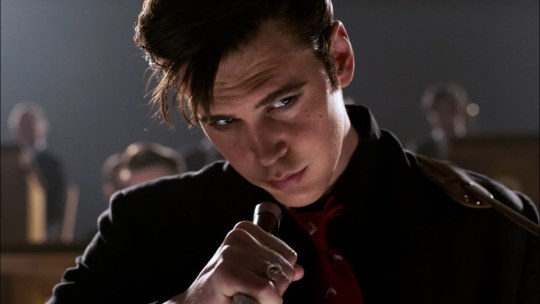
Over the past few years we’ve had a slew of mediocre music biopics, often boasting a great central performance but never understanding their subject, which makes it a delightful surprise to have a film like Elvis come along. Baz Luhrmann took the story of an icon and told it with the energy and glamour that make the Director so distinct. But, what’s even more impressive is how the film understands just how emphatic Elvis Presley was as an icon.
The film is by no means perfect, with Tom Hanks not quite hitting the mark as well as his co-stars, but this should be the definitive blueprint for music biopics to come. From his room-shaking begins to the darker days of his time in Vegas, Elvis tells us the story while never forgetting to inject the passion and personality that made Elvis Presley one of the most iconic performers of all time. Also, it’s impossible not to be impressed by Butler’s spellbinding performance.
5. Women Talking
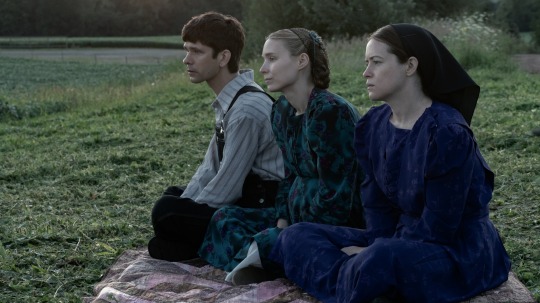
Sarah Polley’s chamber piece rightfully took home the Best Adapted Screenplay award for her talky adaptation of Miriam Toews novel. The script that Polley wrote is a beautiful balance between character, theme and discussion, lending personality and importance to create one of the most timely films of the year.
While Polley’s script is what shines the most it cannot be understated how important her direction is. Instead of being flashy and overbearing she opts for quiet and observational direction that allows her characters to shine with their own heartbreaking individuality. Like all great chamber pieces, Women Talking densely packs its small setting with so much – leaving you eternally affected by the film’s outcome.
4. All Quiet on the Western Front
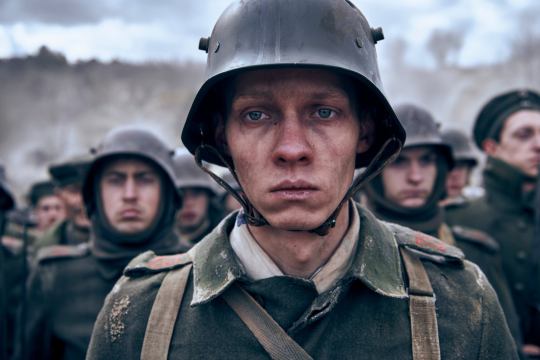
Edward Berger’s adaptation of Remarque’s novel takes a modern approach in its filmmaking to really hit home the timeless themes of the classic source material. Every battle scene is wonderfully constructed in order to capture the “War Is Hell” mantra of the film while never losing those individual struggles we see from the leading characters.
There are different threads that the film pulls on that don’t work quite as well as the core story, but these merely provide extra layers to a film that’s already packed densely with story. War films have to really do something special to stand out these days and Edward Berger has ensured that his film stands head and shoulders above a lot of films of a similar ilk.
3. Tár
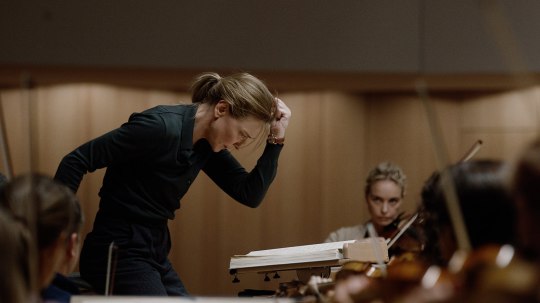
At times Todd Fields’ near 3-hour character piece can feel strenuous. The script never hides away from the world it’s set in, often allowing long stretches of dialogue about Classical music to play out in front of its sturdy camera, but the film succeeds because of its subtle character evolutions. You’d be quick to dismiss this film as a discussion on “cancel culture” or even the separation of Art vs. Artist, but really what it’s doing is building everything into its central character.
Smartly made and marketed like a biopic, the film takes a grounded approach of talking about people who are considered otherworldly. Every action, conversation and thought Lydia Tár experiences is slowly etching away her mythical persona as one of the greatest composers of all time – until it all implodes in glorious fashion. The film will likely be remembered for Blanchett’s wonderful performance, but there is a quiet complexity to Tár that stays with you for a long time.
2. Banshees of Inisherin

Martin McDonagh’s newest film is arguably his finest work. In Bruges loyalists will always argue against that, but McDonagh’s signature style has never felt more fluid than in Banshees of Inisherin. Not only that, but the razor sharp humour wonderfully compliments the quiet melancholic tone – as well as the allegory for the Irish Civil War.
McDonagh surrounds himself with the familiar faces of Colin Farrell and Brendan Gleeson who, along with the addition of two wonderful performances from Kerry Condon and Barry Keoghan, anchor this film’s themes perfectly. The chemistry seeping from every scene shared between the cast amplifies the humour but also gives the film a sense of community, reaffirming the bigger questions of death and legacy, as well as the impact we have on those around us.
1. Everything Everywhere All At Once
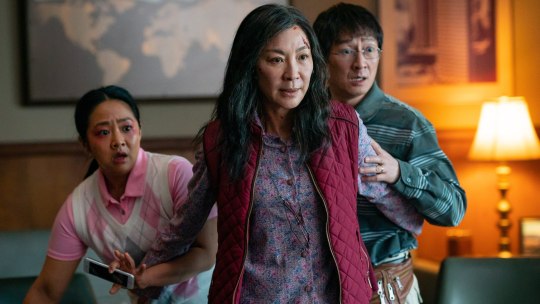
Easily the most original and unpredictable film of the year – maybe even of the current decade – The Daniels’ bizarre vision of the multiverse is told with veteran control. You easily find yourself in awe of the film’s barbaric narrative, but what’s even more impressive is the it’s ability to find so much heart at the centre of its chaos.
Amongst the confetti action, hotdog fingers and hundreds of other elements The Daniels pack into their film there is a quietly controlled narrative between Mother and Daughter, exploring their lack of connection and the solace they find in that shared experience. It’s a narrative that is extremely hard to balance at the best times but doing it with so much craziness surrounding it – as well as challenging a suffering marriage as well – is why this film easily stands as the best film nominated for Best Picture. Everything Everywhere All At Once won big at the Oscars and for the first time ever there isn’t a soul out there that can argue against with the wins.
#film#movies#film list#movie list#cinema#oscars 2023#academy awards#film review#oscars#everything everywhere all at once#the banshees of inisherin#tar#all quiet on the western front#women talking#elvis#top gun maverick#the fabelmens#triangle of sadness#avatar way of water#filmsfromreel
43 notes
·
View notes
Text

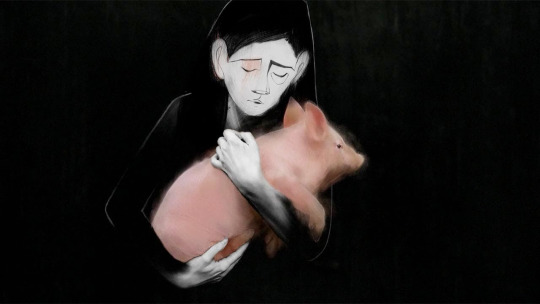



Best Animated Short Film Nominees for the 96th Academy Awards (2024, listed in order of appearance in the shorts package)
This blog, since 2013, has been the site of my write-ups to the Oscar-nominated short film packages – a personal tradition for myself and for this blog. This omnibus write-up goes with my thanks to the Regency South Coast Village in Santa Ana, California for providing all three Oscar-nominated short film packages.
If you are an American or Canadian resident interested in supporting the short film filmmakers in theaters (and you should, as very few of those who work in short films are as affluent as your big-name directors and actors), check your local participating theaters here.
Without further ado, here are the nominees for the Best Animated Short Film at this year’s Academy Awards. The write-ups for the Documentary Short and Live Action Short nominees are complete. Films predominantly in a language other than English are listed with their nation(s) of origin.
Yet again, this completes this year’s omnibus write-ups for the Oscar-nominated short films for the upcoming Academy Awards:
Our Uniform (2023, Iran)
Director Yegane Moghaddam used to be a primary school teacher in Iran and often “observed the students… struggling with their uniforms and headscarves all day.” These observations informed her film and narration in Our Uniform, which won Best First Film at Annecy (the largest animation-only film festival, in the French Alpine resort town of the same name) in 2023. Only the fourth ever non-Western/European and non-Japanese nominee in this 92-year-old category – following 2014’s Bear Story (Chile; that year's winner), 2020’s Opera (South Korea) and 2021’s Bestia (Chile) – Our Uniform adopts a unique style never before seen in this category. Instead of traditional cel animation with ink and paper or computers, Moghaddam nearly single-handedly painted images directly on clothing fabrics (pants, jackets, shirts, scarves – all from her personal wardrobe) to illustrate the memories her narration shares. These memories, of attending public school in Iran, invariably intersect with Iran’s theocratic politics. There are references, never pedantic, about government propaganda as part of the school curriculum, and the segregation between boys’ and girls’ education. Most vividly, Moghaddam remarks on the restricting school uniform and compulsory hijabs for girls at school, issues which enflamed protests against such laws beginning in 2017 (and spiking after the death of Mahsa Amini in 2022).
Moghaddam, who cites graphic novelist/director Marjane Satrapi (2007’s Persepolis, 2011’s Chicken with Plums; the former I consider among the finest animated films of this young century) as her primary artistic inspiration, curiously does not contain as much messaging in her film as one might expect. As an Iranian citizen who currently has no plans to officially distribute the film within her home nation due to fear of retribution, how could she? But the film’s slightness cannot distract from its painstaking, loving artistry. Without relying on inventive camerawork, Moghaddam uses the natural pockets and folds of her clothes to suggest dimension and personality. To Moghaddam, all clothing has a personality and personal history to the wearer, even compulsory clothing, all of which she uses to wonderful effect. What originally began as a fun side project that Moghaddam had no expectations for gifts audiences a truly original viewing experience.
My rating: 7.5/10
Letter to a Pig (2022, Israel/France)
Qualifying for the Academy Awards after winning the Grand Prize for Best International Short Film at Anima, the Brussels Animation Film Festival, in early 2023, Nal Kantor’s Letter to a Pig sees a Holocaust survivor retelling a story of survival to a group of largely disinterested and scornful teenagers. As the elderly man recounts how he wrote a letter to a pig that inadvertently saved his life, a handful of students start insensitively snorting. Quietly, Letter to a Pig adopts the standpoint of one of the girls in class, half-listening at first. Here, Kantor seamlessly switches between the man’s memories and the reality of the classroom, through heavy rotoscoping to outline her figures, mixing it with live-action footage for the limbs or eyes, but only using a few ink scribbles to outline facial features and hair. Generally, the more movement either the schoolgirl or Holocaust survivor show, the more scribbles and live-action footage that appear. For all other figures, they remain mostly abstract.
As a young man, the Holocaust survivor recalls how filled with rage he was, long after his near-death encounter. Now, physically unable to exact retribution on those who harmed him, he tells the students “you are my revenge” – passing along his trauma to those not realizing what they have just received. The schoolgirl’s vision in the surrealistic final minutes is her absorption of the Holocaust survivor’s story. This masterfully drawn finale is the emotional apex of Letter to a Pig, fully justifying its black-and-white palette (with one exception: pink for the pigs, considered an impure animal in Judaism) in service for its profound sense of dread. Symbolizing memory, the pig appears throughout the film as a savior, a monster, or something worthy of mockery, depending on who is on screen. It is in these final moments Letter to a Pig leaves the audience with pressing questions. Can one impart painful memories without the trauma that gives such memories form? Most urgently, can we choose not to act on the trauma we inherit? May it be possible not only in dreams.
My rating: 8.5/10
Pachyderme (2022, France)
Stéphanie Clement’s Pachyderme, like Letter to a Pig, is an unsettling short film that delves deeply into the mind of a troubled character. In this film, a young woman named Louise (Christa Théret) recalls her days visiting her grandparents in Provence (southeastern France) during her childhood. The sun-bathed rural landscape is picturesque, the grandparents’ house gorgeously stylized. Beyond this, some of Louise’s recollections feel incomplete, with no apparent structure or chronology. That might read as a criticism, but Clement and screenwriter Marc Rius fully intend for Pachyderme to seem fragmented. The film strongly implies – and some viewers will pick this up earlier or later than others – that the grandfather sexually abused Louise. In reaction, Louise, while recounting her memories for the audience, has repressed her memories and is showing signs, in her narration and in her visual recollections, of disassociation. I do not recall ever seeing disassociation, a common symptom of those who have been sexually abused, portrayed as cinematically as seen in Pachyderme. It is best exemplified, metaphorically, in the scene where our protagonist disappears into the wallpaper (this scene was originally the first bit of test footage made for the film).
But perhaps there is no better visualization of all Pachyderme has to say than the moment where Louise’s grandfather notices her index finger bleeding. He grasps her hand, and his hands dwarf hers. The simultaneity of Pachyderme’s picture book visuals and its horrifying implications show the viewer a woman who has not fully processed what has happened to her. It is not helped by the defensiveness of Louise’s grandmother following the grandfather’s death. Family denial, too, is playing a role in how Louise is choosing, consciously and subconsciously, to remember the past. In its eleven minutes, Pachyderme passes in a dreamlike haze, its illusory moments enabling the viewer to more closely connect to Louise’s (both the young adult narrating the film and the child on-screen) feelings. Unlike many nominees in Best Live Action Short Film down the years that addressed childhood trauma (it's a long-running trend for that category), Pachyderme prioritizes healing in as cinematic a way as possible.
My rating: 8.5/10
Ninety-Five Senses (2023)
If the names Jared and Jerusha Hess are familiar, that is because this husband-and-wife directorial team also made Napoleon Dynamite (2004) and Nacho Libre (2006). Some of those same comedic sensibilities carry over to Ninety-Five Senses, which qualified for the Academy Awards by winning Best Animated Short at the Florida Film Festival in 2023. The film features an old man named Coy (Tim Blake Nelson, a Coen Brothers regular whose voice fits the narrative here) reflecting back on life – a reverie that jumps, hops, and skips across time and place. At first, Ninety-Five Senses, with its wildly shifting style changes, does not seem to have much of a point or purpose. But the film gradually reveals itself: first through the subtle shading of what appear to be prison bars and, later, the mountain of discarded food cartons sitting on the table in front of Coy. We soon realize that Coy is in the final hours or minutes of being on death row, and he is describing to the audience his internal peace before he meets his fate.
Ninety-Five Senses is not here to make a point about capital punishment, incarceration, or the terrible actions that landed Coy in prison. Foremost, this is a film that attempts to capture the last gasp of humanity of an individual before their execution. In contrast with the drab grays whenever Coy is seen in his cell, his flashbacks are intense – a fount of color, with both crude and elegant character designs, hand-drawn and computer-generated (sometimes appearing side-by-side). Not every vignette – of which there are five, one for each human sense – showcases as much aesthetic excellence as the others, such as an early instance where Coy recounts his childhood. That vignette does not evoke the respective human sense it covers as well as it thinks it does; the art style of that vignette also recalls hand-drawn television animation, but flows too smoothly to exactly replicate it. In any case, this is a promising first foray into animated film for the Hesses.
My rating: 8/10
War Is Over! Inspired by the Music of John and Yoko (2022)
War Is Over! (you cannot make me write or say the full title ever again) has the basics of a promising animated short film. Yet its simplistic take on humanity and warfare and close association with John Lennon and Yoko Ono’s “Happy Xmas (War Is Over)” condemns the film as pure hogwash. On second thought, I retract “hogwash”. That is an insult to Letter to a Pig and to porcine animals. This is self-congratulatory treacle from director Dave Mullins and co-writer Sean Ono Lennon (the son of John and Yoko). In a supposedly alternate World War I reality, a pigeon delivers messages between an Allied and a Central Power soldier on opposite sides of No Man’s Land. The messages contain chess notation, as they, somehow, began a game of chess with each other without ever meeting. One day, at presumably Christmas, the two armies inexplicably charge toward each other and, amid gunfire and a mass mêlée that should leave many more soldiers dead than shown, our two soldiers encounter each other on the battlefield in combat shorn of its gruesomeness.
Despite the film using the Unreal Engine for its animation, I admire the film’s lighting effects, character movements, pigeon animation, sound effects, and art direction for the otherwise sanitized trenches. That may be all the positives I can offer.
The contrived scenario sinks even further when our two chess-playing soldiers discover a critical message from their pigeon messenger. Cue the second-most embarrassing needle drop among this year’s fifteen short film nominees (somehow, the closing moments of The After are worse than this). Unlike The After, War Is Over! feels as if constructed around its respective song. Is this now a glorified music video? In an instant, the film reduces the tragedy of the Great War to something akin to a soft drink commercial or that “Imagine” video (could we stop disrespecting John Lennon and his fellow Beatles?). The sanitized depiction of war and farfetched resolving actions undercut the film’s message, embarrassing itself as it lurches through its excruciating final minutes. That the first credit in the end credits read “music and message by John and Yoko” rather than director Dave Mullins leaves an even more sour taste. At the heart of War Is Over!, Mullins and Sean Ono Lennon want us to know that war is bad. I never could have guessed!
My rating: 4/10
^ Based on my personal imdb rating. My interpretation of that ratings system can be found in the “Ratings system” page on my blog. Half-points are always rounded down.
From previous years:
85th Academy Awards (2013)
87th (2015)
88th (2016)
89th (2017)
90th (2018)
91st (2019)
92nd (2020)
93rd (2021)
94th (2022)
95th (2023)
Two other films played in this package as honorable mentions: Wild Summon (2023, dir. Karni Arieli and Saul Freed; 6/10) and I'm Hip (2023, dir. John Musker; 6/10).
For more of my reviews tagged “My Movie Odyssey”, check out the tag of the same name on my blog.
#Our Uniform#Letter to a Pig#מכתב לחזיר#Pachyderme#Ninety Five Senses#Ninety-Five Senses#War Is Over!#War Is Over! Inspired by the Music of John and Yoko#Yegane Moghaddam#Tal Kantor#Stéphanie Clément#Jared Hess#Jerusha Hess#Dave Mullins#Sean Ono Lennon#Tim Blake Nelson#96th Academy Awards#Oscars#31 Days of Oscar#My Movie Odyssey
4 notes
·
View notes
Text
Happy birthday, Buster Keaton!
Today is Buster Keaton's 127th birthday. Usually, my birthday posts for Buster wax poetic about the impact he's had on me, but this year I've decided to talk about my favorite Keaton film-- which also happens to be my favorite movie of all time-- The General. Perfect time too, since I watched the film again recently to celebrate Keaton's big day.
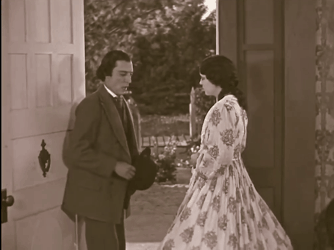
Ever humble and practical, Keaton would have never called himself an artist, and yet The General is undoubtedly more than a gag machine. It's one of the most visually appealing movies ever made-- Keaton and his creative team took the greatest care to replicate the Civil War photography of Matthew Brady, resulting in gorgeous compositions, evocative lighting, and a strong sense of period accuracy that outdoes most "serious" historical dramas of its time (and hell, ours too).

The elegance of the visuals is reflected in the taut, symmetrical, perfectly paced story. Critic Imogen Smith once said of The General in her IMDB review, "The General's narrative structure is as strong and uncluttered as its look. Like a train, it stays on track, never meandering for the sake of a laugh or a stunt. All of the gags rise organically from the coherent and straightforward storyline." On this recent rewatch, I was stunned by how quickly Keaton cuts to the chase (no pun intended). It truly is action-packed from start to finish.

Though the thing about the action in The General is that it isn’t of the over the top variety. Keaton’s antics on that 100% real moving train are not faked and that is a thousand times more thrilling than any CG setpiece in any superhero movie made in the last twenty years. So much of what he does in this movie could have killed him even if he had made only the slightest error, and yet Keaton somehow makes it all seem effortless. He never seems to be showing off what he can do or how expensive this all was-- as Imogen Smith says, even the famous shot were Keaton trashes a real train is presented with absolute understatement, something most Hollywood filmmakers would be loathe to do, then or now.
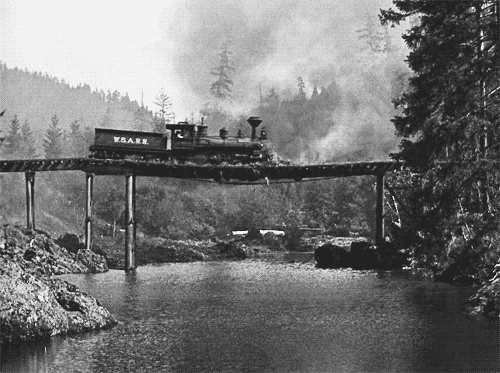

This movie has everything you could want packed into 80 minutes-- comedy, suspense, and action. I gasp and laugh every time I see it, and it’s a treat to watch with newbies, even those who wouldn’t normally take a chance on a silent film. For me, it is the finest movie Keaton ever made, one of the finest of the silent era, and one of the best movies of all time.
Happy birthday Buster-- and thank you so much.
68 notes
·
View notes
Text
Bollyflix in Download Watch Dual Audio Hollywood Full HD
Step into the enchanting world of Bollywood with BollyFlixin, the premier platform for Bollyflix movies download. Beyond just streaming, BollyFlixin offers a gateway to the heart and soul of Indian cinema, providing an immersive experience that celebrates the vibrant tapestry of Bollywood. Let's explore further into the captivating realm of BollyFlixin and discover the wonders of Bollyflix movies download.
BollyFlix Twitter: https://twitter.com/Bollyflix2024
Download New Movie Godzilla x Kong The New Empire Dual Audio in Hindi Full HA 1080p: https://bollyflixin.com/godzilla-x-kong-the-new-empire-movie
A Treasure Trove of Bollywood Delights
BollyFlixin isn't your average streaming service—it's a treasure trove of Bollywood's finest offerings. With an extensive collection of blockbuster hits, timeless classics, and hidden gems, BollyFlixin invites you to immerse yourself in the rich tapestry of Indian cinema. From epic sagas to heartwarming romances, BollyFlixin offers a diverse array of cinematic treasures, all available for convenient download.
Seamless Bollyflix Movies Download
With BollyFlixin, the thrill of Bollywood is just a click away. The platform not only provides seamless streaming but also offers the option to download your favorite movies for offline viewing. Whether you're on a long journey, relaxing at home, or simply want to enjoy Bollywood magic without an internet connection, BollyFlixin ensures that you can indulge your passion for Indian cinema anytime, anywhere.
Immerse Yourself in the World of Bollywood
BollyFlixin isn't just about entertainment—it's a celebration of Indian culture and heritage. Through its curated selection of Bollywood movies, the platform offers a window into the colorful tapestry of Indian life and tradition. From the bustling streets of Mumbai to the majestic landscapes of rural India, BollyFlixin invites you to immerse yourself in the sights, sounds, and stories of Bollywood.
Ignite Your Love for Bollywood
Whether you're a seasoned Bollywood aficionado or new to the world of Indian cinema, BollyFlixin caters to all levels of passion. With its user-friendly interface and vast library of movies, the platform encourages you to ignite your love for Bollywood and explore the boundless creativity of Indian filmmakers. Whether you seek entertainment, inspiration, or cultural enrichment, BollyFlixin offers an enriching and immersive experience for everyone.
Join the BollyFlixin Family
Are you ready to embark on an unforgettable cinematic journey? Join the vibrant community of Bollywood enthusiasts on BollyFlixin and elevate your movie-watching experience to new heights. With its commitment to excellence and innovation, BollyFlixin promises an adventure through the magical world of Bollywood that you won't soon forget. Experience the joy of Bollyflix movies download with BollyFlixin, and let the cinematic magic unfold.
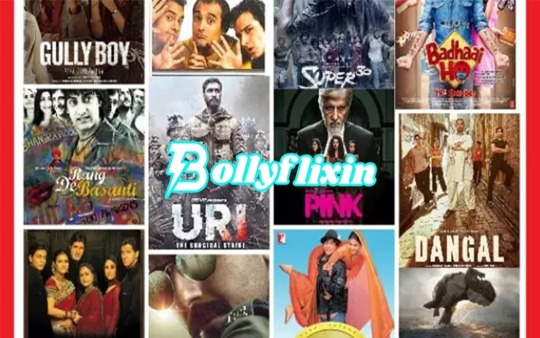
2 notes
·
View notes
Text
Unveiling the Glitz and Glamour: Oscars 2023 Recap and Oscar Awards Insights

The Oscars, also known as the Academy Awards, stand as the epitome of excellence in the realm of cinema. Every year, Hollywood's finest talents gather to celebrate outstanding achievements in filmmaking. The Oscars 2023 edition was no exception, as it dazzled audiences worldwide with its grandeur and sophistication.
Oscars 2023: A Night to Remember
The Oscars 2023 ceremony, held at the iconic Dolby Theatre in Los Angeles, was a spectacle to behold. A-list celebrities graced the red carpet in their most exquisite attire, setting the stage for an evening filled with anticipation and excitement.
Oscars Nomination 2023: The Best of the Best
Leading up to the main event, film enthusiasts eagerly awaited the announcement of Oscar nominations. The Oscars 2023 nominations showcased a diverse array of cinematic masterpieces, representing various genres and storytelling styles. From gripping dramas to captivating documentaries, each nominee exemplified the artistry and creativity prevalent in the film industry.
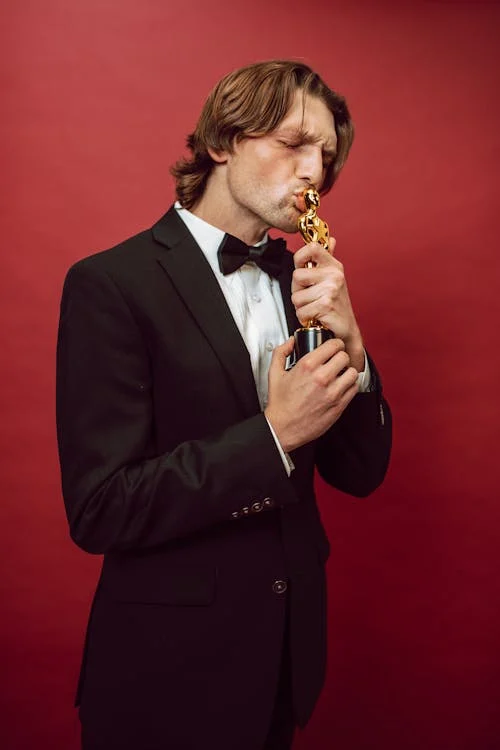
Oscars Winners 2023: Celebrating Excellence
As the night unfolded, stars took to the stage to claim their coveted Oscars trophies. The winners of Oscars 2023 represented a mix of seasoned veterans and emerging talents, all recognized for their exceptional contributions to cinema. From Best Picture to Best Director, each category honored the passion and dedication poured into bringing captivating stories to life on the silver screen.
Academy Awards 2023: A Platform for Diversity
One of the highlights of Oscars 2023 was its emphasis on diversity and inclusion. The Academy Awards celebrated filmmakers from various backgrounds, shining a spotlight on stories that resonate with audiences worldwide. From celebrating films that explore social issues to recognizing underrepresented voices, the Oscars underscored the importance of representation in storytelling.

Oscars Wins: Inspiring Future Generations
Beyond the glitz and glamour, the Oscars serve as a source of inspiration for aspiring filmmakers and artists. The wins at Oscars 2023 inspire a new generation of creatives to pursue their dreams and strive for excellence in their craft. The Academy Awards not only recognize outstanding achievements but also encourage innovation and experimentation in filmmaking.
Reflecting on Oscar Awards: A Legacy of Excellence
As we look back on Oscars 2023, we're reminded of the enduring legacy of the Academy Awards. For decades, the Oscars have celebrated the magic of cinema, uniting audiences around the world in appreciation of storytelling and artistry. As we eagerly anticipate the next chapter in Oscars history, we cherish the memories and moments that make the Academy Awards a true celebration of the silver screen.
In conclusion, Oscars 2023 was a testament to the power of film to entertain, enlighten, and inspire. As we celebrate the winners of Oscars and reflect on the achievements of the past year, we eagerly await the next installment of the Academy Awards, where new stories will be told, and new stars will shine bright on Hollywood's biggest night.
#oscars#art#the oscars#oscars 2024#academy awards#oppenheimer#killers of the flower moon#free palestine#free gaza#palestine#cats of tumblr#naturecore#nature#photography#dimension 20#caturday#photographer
3 notes
·
View notes
Text
2024 Oscars Best Live Action Short Predictions
Many filmmakers who helm shorts and other independent films don’t like it when established auteurs and artists come into their space in the shorts categories.
That’s why big names like Wes Anderson (“The Wonderful Story of Henry Sugar”), Pedro Almodóvar (“Strange Way of Life”), Alfonso Cuarón (“The Shepherd”) and David Oyelowo (“The After”) aren’t as guaranteed as many may think, but with three, there’s more in the mix than in previous years.
After getting passed over for “The Human Voice” (2020) with Tilda Swinton, Almodóvar returns with a pair of beloved leading men — Ethan Hawke and Pedro Pascal in his gay western. Referencing Westerns such as Jane Campion’s “The Power of the Dog” as a source of inspiration, the auteur puts his signature imagery on display and, with the backing of Sony Pictures Classics, should be able to fit into the lineup.
Aren't Pedro Pascal and Ethan Hawke LUCKY, if not that popular? They're being submitted in the Short Films category for doing a RIP OFF of The Power of The Dog, for which A list actor, Benedict Cumberbatch was publicly castrated he did so. Hollywood hypocrisy, at its finest.
#Strange Way of Life Is A Rip Off Of The Power of The Dog#And NO#Pedro Pascal and Ethan Hawke are only popular to Hollywood because they need them to be#Oscars 2024#SAG-AFTRA#Fucking Hypocrites
2 notes
·
View notes
Text
my top five list of favorite movies that nobody asked for (a working list)
edit to add i can't believe i found gifs for all these WOW i am basic i guess
Jurassic Park. for many and all reasons but mostly that one VHS tape i still have that has been used and abused. i can quote this movie forward and back and this is where my love of cinema really truly began. thank you Spielberg for your service.

2. Bird on a Wire. my sexual awakening started with Mel Gibson in this movie and to this day it is still my favorite rom-com of all time, and has 100% set the bar for rom-coms and my relationship with them.

3. Lonesome Dove & Tombstone. yes this is a two-fer, because they are both westerns. no i will not be taking recommendations and there will be no other greater westerns added to this list thank you (except maybe for the outlaw josey wales but right now i am confident in my picks thank you).


4. Real Genius. this is a new one for me but i absolutely cannot deny how classically funny and necessary a gag-script is in a favorite-movies list. Val Kilmer steals this movie and gives a performance that's 10/10. comedy at its finest.
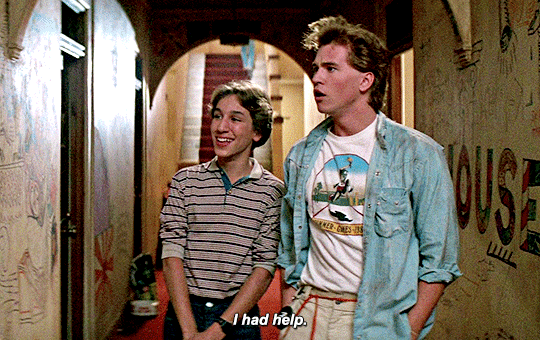
5. Transformers: The Movie (1986) & Transformers (2007). this set me on my path to transformers obsession and, thus, fundamentally changed the fandom game and my life. yes bayverse is trash but it's MY trash and it holds a special place in my heart, even if i do simmer with rage a little. also launched me into fanfiction.


honorable mentions
A. Batman Forever. arguably my start in fanfiction, next to transformers, and eventually evolved me into the batman obsessee i currently am. still my favorite interpretation of bruce wayne, next to Christian Bale--Nolanverse was also considered for this list, but Forever came first.

B. Top Gun. for a brilliant script and some absolutely insane improv when it comes to filmmaking and rallying an all-star cast. really put my boys Tommy and Val on the map with this one. a good, old-fashioned American action movie about a bunch of guys serving their country. you can't get better than that.

C. James Bond. very specifically Goldeneye--I have seen this film no less than a dozen or two times simply because my dad is a huge Bond man. Pierce was always my favorite and still is. my best memories of my dad are watching these movies.

D. Toy Story. the original. because I'm not crazy (and also #3 because that incinerator scene KILLS me). baby miriam got her all-out fandom-obsessed personality from here. this was the start of my fandom journey. i still have the Woody doll my mom got me from mcdonald's that really set the bar high with happy meal toys.
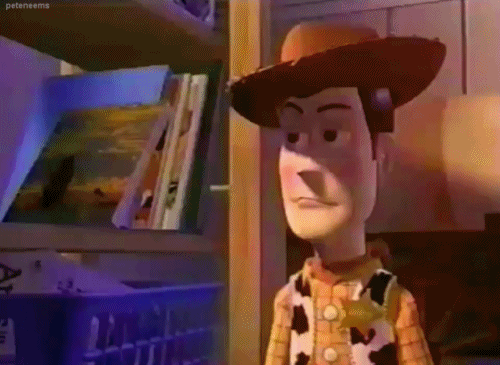
E. Free Willy. when I say i was obsessed with this series i am not lying. at all. my tiny baby heart just swooned over the entire concept of marine biology and specifically Jesse.

F. Lethal Weapon. another series i associate with good memories with my father. note the Mel obsession. the first sex scene i ever peeped was #3.

G. Waterworld. Kevin was HARD CRUSH. and during the peak time of my life being obsessed with water and wanting to do marine biology? yes.
#roostette's cult classics#working list#for now#top five beatdown#movies#film#its a fangirl thing shhhhh
11 notes
·
View notes
Text
Excerpts from a review at them.us:
It’s the sort of premise that works well in literary form, where we have more direct access to the characters’ interiority — and indeed, Shyamalan and his collaborators have adapted this film from Paul Tremblay’s The Cabin at the End of the World, albeit with some major plot revisions. But Shyamalan draws tremendously affecting performances out of everyone involved, especially Groff and Aldridge, to the point that the novel’s close third-person narration is barely missed. In so doing, the horror director produces his finest work since The Sixth Sense and delivers one of the more moving queer-themed genre films in recent history.
At its core, and beneath its high-concept trappings, Knock is a family story: Eric is uptight, Andrew has a temper, but they love each other and would do anything to protect their “miracle,” Wen. The movie’s LGBTQ+ representation hits the exact (and often elusive) sweet spot between being casual and pronounced. The homophobia that Eric and Andrew have endured over the course of their relationship is real, shown in painful flashbacks, but there is nothing didactic about that acknowledgement. Those scenes from the past serve a purpose, for both plot and characterization, and avoid coming across like Very Special Episodes.
I never would have expected Shyamalan, who — speaking of sacrifice — often offers up his own characters on the altar of abstraction, to nail this balance. But in Knock, Shyamalan seems to have matured enough as a filmmaker to stay put, confining himself largely to a single location, keeping his lens focused on Eric and Andrew’s pained faces. He avoids big twists in favor of tight close-ups and the occasional monologue. Shyamalan wants you to believe this family’s love for each other, and thanks in large part to Groff and Aldridge, he succeeds.
This family is just like any other family, but it also isn’t. Love is love, but also — as Billy Eichner’s character memorably puts it in Bros — love is not love; queer love is different. For some reason, it seems impossible for many filmmakers to hold those two ideas together. The temptation is strong to either homogenize or tokenize — to make LGBTQ+ characters either the same as everyone else or markedly other. Shyamalan avoids that temptation here, letting the family be messy, imperfect, and all the more likable for it. That surprising human touch only accentuates the director’s long-established talents for crafting suspense and framing shots. For all his past foibles, the man knows how to construct an image.
Knock is many things: a parable about the end of the world, a study in belief, a thriller perfectly poised for our misinformation era. But in addition to those layers of meaning and metaphor, it is also a film about the beauty and fragility of building a queer family. Eric and Andrew have overcome so much to create something that’s at risk of being capriciously destroyed. The movie understands something that queer people know on a gut level: we are strong, but we are outnumbered and we are, after all, only human.
I won’t say how Knock ends, suffice it to say that a certain 1975 disco hit becomes a genuinely gutting musical cue. But I will say that it made me do two things I never expected to do while watching an M. Night Shyamalan film: cry and feel proud to be queer.
14 notes
·
View notes
Text
'Towards the end of All of Us Strangers – the exquisite new film from writer-director Andrew Haigh, based upon a novel by Taichi Yamada – Adam (played by the beautiful, elegant Andrew Scott) makes a distressing and heartbreaking discovery while exploring an unfamiliar room in his near-vacant apartment building.
As Adam enters this room, Haigh and cinematographer Jamie M. Ramsay linger over his shocked expression. The camera places him at right, with negative space hovering between his gaze and that terrible surprise, to the left, which is physically out of frame.
For a time, watching this shot, which lasts for quite a while, I cowered in my seat. I did not want to see whatever it was that Adam was looking at. I sensed what it was, and did not need to see it. I directed my eyes toward the corner of the auditorium, with the theater screen in my peripheral, to avoid direct engagement with the terrible thing once Mr. Haigh finally cut to it.
Yet he never did cut to it. The shot continued, focused entirely on Adam, until he stepped closer towards the terrible thing. At that point, just enough of the thing appeared in frame to confirm my suspicions. But neither Haigh nor Ramsay subjected me or anyone else in the audience to the gratuity, to the shock of that thing which Adam had uncovered. They never forced it on us.
I can’t begin to express my admiration for Mr. Haigh’s choice. It is a rare thing for a filmmaker to refrain from showing something carnal or violent onscreen – to not, in fact, seek out an opportunity to do so. Usually, whenever someone is attacked or killed or found dead in movies, it is an elaborate tableau of guts and blood.
Not so here. Like everything else in All of Us Strangers, Andrew Haigh handles the difficult or crushing moments with grace. He honors his characters’ dignity, and allows them room to remain embodied. Without dismemberment, or voyeuristic exploitation.
I’m tempted to say that this relationship to visual material represents a distinctly gay point of view. Mr. Haigh is gay, as is Adam, as is the man who plays him; this is in and of itself an unusual configuration for a Hollywood movie: to have maker, character, and performer alike all identify as gay. It means that many of the common reference points cherished by male directors – fetishized women, aggressive behavior, combative worldviews – fall by the wayside.
In their place? A regard for male beauty. Slow, contemplative action. Healing, not conquest, as the primary objective.
It may be an oversimplification to say so, but I regard All of Us Strangers as the best in what queer commercial filmmaking might offer: delicacy, honesty, and human consideration. I agree with everything that Andrew Haigh says and does in this movie.
And while we’re extolling exemplars in queer artistry, let’s delegate some verbiage to Mr. Andrew Scott. It may simply be that I identify with his character – a gay man who spends most of his time alone, writing screenplays and mulling over his past – but I consider this the gentlest, most alluring of performances. He emits the modest gentility of James Mason; he blinks and breathes with gentlemanly yet frank clarity. He is gorgeous.
And he is flanked by Paul Mescal, as his lover, matched by Claire Foy and Jamie Bell, as his parents. All reached for, all tentatively available to him. All resplendent performers, all present for their roles. Their individual beauty coalesces in a collective, intimate grandeur. I am in love with them all, and I am in love with the process of healing Adam undertakes as he encounters them.
All of Us Strangers is basically a chamber drama, unfolding in one man’s imagination. Its disciplined humility expands with the skyline outside Adam’s window, so that what functions as a limited portrait of grief becomes epic. It is harrowing and reassuring all at once.
A blessing, this. I respect it. I am grateful it exists.'
#Andrew Haigh#Strangers#Taichi Yamada#All of Us Strangers#Andrew Scott#Paul Mescal#Claire Foy#Jamie Bell#Jamie D. Ramsay
6 notes
·
View notes
Text

The young Kushar twins
1942 – George and Mike Kushar are twin gay American underground filmmaker, actors, and cartoonists. They are notable for their low-budget and camp films such as Sins of the Fleshapoids, The Craven Sluck and Ascension of the Demonoids.
When Mike and George Kuchar first got their hands on an 8mm movie camera in 1954 as 12 year old boys, no one really thought the format was suitable for anything but vacation footage, yet since then no one in America has contributed more to the craft and philosophy of personal film-making than the twin brothers from the Bronx. In a culture of hype and careerism, where "size counts", its not surprising, then, that gangly, self-effacing Mike Kuchar, the lesser well known of the two, is not in any sense famous.
They have been making innovative, if engagingly threadbare, epics since that day in 1954, when The Wet Destruction of the Atlantic Empire saw the light of day. In that case, the boys' appropriation of all available materials included their mother's nightgown. According to George, "At the age of twelve I made a transvestite movie on the roof and was brutally beaten by my mother for having disgraced her, and also for soiling her nightgown." Mrs. Kuchar's reaction was the Kuchars' first bad review, but it is a testimony to how endearing they and their work are that by the mid-1960s she was making regular cameo appearances in her sons' work. Devotees of comic books, pornography, and commercial Hollywood cinema, George and Mike tried to replicate on film what they saw in their working-class lives—or filter it through their own gay sensibilities—using their 8mm camera and whatever locations, props, friends, and families were available.
Wet Destruction was followed by many other works in the comic chaos mode, torrid two-dollar melodramas based on Kuchar favorites such as Douglas Sirk's Written on the Wind (1956). Some of the titles are as notorious as the films themselves: Corruption of the Damned (1967), Pussy on a Hot Tin Roof (1961), Hold Me While I'm Naked (1966). Many featured shoestring special effects that included floods, earthquakes, and tornadoes, rendered with stock footage, backyard assemblages, and matte paintings by the talented duo.
The Kuchars were innovative exhibitors as well, setting up informal cinema clubs to show their work, which scandalized some of the attendees with its sexual frankness, anarchistic air, laughable plots, and grade-Z special effects. Eventually members of the haute underground —Andy Warhol, Ken Jacobs, Jack Smith — took notice, and the Kuchars' films became both infamous in creating their legend and influential in showing others that neither large budgets nor good taste were necessary conditions of film art
Mike and George ended their collaborative approach to movie making in 1965 when Mike phased himself out of their first 16mm work-in-progress, Corruption of the Damned, to concentrate on a futuristic science-fiction fantasy which would turn out to be the 45-minute Sins of the Fleshapoids, and which featured George in probably his finest acting appearance as Gianbeano, the evil prince.
Although their films would always display some stylistic similarity, reflective of their common love of fifties' Hollywood melodrama and their low-budget orientation, Mike dealt more with classical or Romanesque imagery that tended to have erotic under-currents, while George would go on to pioneer a form of personal film-making that relied heavily on first-person narration and his own presence in the frame - a style which he has honed in his prolific "video-diary" output of the last decade. Mike has always taken a more off-screen role in his own films, which are just as personal but in a different way, and tend on average to be longer than George's.
George went on refining the steamy camp melodrama, using a stock company of friends, and, later, working in a diary format that allowed him to record with droll humor the nuances of his daily life and his self-proclaimed "favorite topic," Midwestern tornadoes. In the early 1970s he became a cartoonist in the underground comics scene but continued to make films. In 1975, George collaborated with the late gay filmmaker Curt McDowell for one of the underground's best-known titles, Thundercrack!, a lewd sendup of the "old dark house" genre from 1930s Hollywood, which George co-wrote and acted in.
George Kuchar's latest major work, funded by the Rockefeller Foundation, carries his obsession with earthly, fleshly things into the literal stratosphere. Secrets of the Shadow World is a 140-minute digital video epic ostensibly tracking George's attempts to make a "big UFO movie," but it is really an excuse to display the filmmaker's scintillating sensibility and eccentric gallery of friends. In a bizarre tableau that reaches the giddy heights of camp, he shows the Roswell, New Mexico alien as a sex fiend, stretched out on top of his friend Linda Martinez, who thrills to the touch of its plastic paw and moody, ovoid bedroom eyes.
Mike's work would span a range of subjects and techniques and he never established a consistent trademark style like George. Even his two major works of the sixties, Sins of the Fleshapoids and The Secret of Wendel Samson (1966), made only a year apart, are very different films. His output over the years was more sporadic and less prolific than his brother's, all of which helps to explain why George has a higher profile than Mike today. George's employment as a film teacher at the San Francisco Art Institute for almost thirty years now has also contributed to his somewhat broader recognition.
On the other hand, Mike has stayed active over the years, working on his own films and occasionally as a cinematographer on other independent productions, usually in Europe. A gifted painter and illustrator since his teens, he's derived some income from story board work and contributed to a number of gay erotic comic books.
In the past 10 years, Mike Kuchar has focused on more intimate one person expressionistic films. At the Vienna Film Festival in 2009, he unveiled two shorts, Swan Song and Dumped. Swan Song features the pain of a young man tormented by his sensuality who is painted as an animal writhing in pain, and Dumped stars veteran stage actress Deirdre McGill in a portrait of a woman engaged in a deadly love triangle.
Mike recently returned from Portugal to San Francisco's Mission District, where he shares a cheap walk-up flat with brother George.
in 1997, the Kuchar brothers collaborated on a book, Reflections from a Cinematic Cesspool (1997). It is a humorous memoir discussing four decades of filmmaking and includes an introduction by filmmaker John Waters


12 A.D. – Caligula was the popular nickname of Gaius Julius Caesar Augustus Germanicus, Roman emperor from 37 AD to 41 AD. Caligula was a member of the Julio-Claudian dynasty. Caligula's father Germanicus, the nephew and adopted son of Emperor Tiberius, was a very successful general and one of Rome's most beloved public figures. The young Gaius earned the nickname Caligula (meaning "little soldier's boot", the diminutive form of caliga, hob-nailed military boot) from his father's soldiers while accompanying him during his campaigns in Germania.
When Germanicus died at Antioch in 19 AD, his wife Agrippina the Elder returned to Rome with her six children where she became entangled in an increasingly bitter feud with Tiberius. This conflict eventually led to the destruction of her family, with Caligula as the sole male survivor. Unscathed by the deadly intrigues, Caligula accepted the invitation to join the emperor on the island of Capri in 31 AD, where Tiberius himself had withdrawn five years earlier. With the death of Tiberius in 37 AD, Caligula succeeded his great uncle and adoptive grandfather.
There are few surviving sources on Caligula's reign, although he is described as a noble and moderate ruler during the first six months of his rule. After this, the sources focus upon his cruelty, sadism, extravagance, and intense sexual perversity, presenting him as an insane tyrant. While the reliability of these sources has increasingly been called into question, it is known that during his brief reign, Caligula worked to increase the unconstrained personal power of the emperor. He directed much of his attention to ambitious construction projects and notoriously luxurious dwellings for himself. However, he initiated the construction of two new aqueducts in Rome: the Aqua Claudia and the Anio Novus. During his reign, the Empire annexed the Kingdom of Mauretania and made it into a province.
Philo of Alexandria and Seneca the Younger describe Caligula as an insane emperor who was self-absorbed, angry, killed on a whim, and indulged in too much spending and sex. He is accused of sleeping with other men's wives and bragging about it, killing for mere amusement, and wanting a statue of himself erected in the Temple of Jerusalem for his worship. Once, at some games at which he was presiding, he ordered his guards to throw an entire section of the crowd into the arena during intermission to be eaten by animals because there were no criminals to be prosecuted and he was bored.
While repeating the earlier stories, the later sources of Suetonius and Cassius Dio provide additional tales of insanity. They accuse Caligula of incest with his sisters, Agrippina the Younger, Drusilla, and Livilla, and say he prostituted them to other men. They state he sent troops on illogical military exercises, turned the palace into a brothel, and, most famously, planned or promised to make his horse, Incitatus, a consul, and actually appointed him a priest.
He assassinated at the Palatine Games by his own officers after a reign of only four years. He was noted for his madness and cruelty including arbitrary murder. His taste in men was far-reaching. In fact, his taste for anything sexual, male, female, relative, or animal seems far-reaching. One of his playmates was a priest who he enjoyed screwing in public at religious events. He forced his officers into regular sex bouts. He is reported to have made them kiss his penis in public.
In early 41 AD, Caligula became the first Roman emperor to be assassinated, the result of a conspiracy involving officers of the Praetorian Guard, as well as members of the Roman Senate and of the imperial court. The conspirators' attempt to use the opportunity to restore the Roman Republic was thwarted: on the same day the Praetorian Guard declared Caligula's uncle Claudius emperor in his place.


1922 – André Baudry (d.2018), as leader of the French homophile movement from the early 1950s into the 1980s, was the principal spokesman for homosexuals in France before the rise of gay liberation in the 1970s. Born in Rethonde, France, on August 22, 1922, Baudry grew up in Senlis, where his father was a notary. After the death of his mother, Baudry, then eight years old, was sent to a Jesuit-run boarding school in Laval. He came down with tuberculosis soon after graduation and spent the first years of World War II in hospital and then in a sanatorium in eastern France. Baudry entered the Roman Catholic seminary at Versailles in 1943, but abandoned his plans for the priesthood in late 1945 or early 1946 because of what he considered an irreconcilable conflict between his religious vocation and his homosexuality. He went on to teach philosophy in a Catholic private school in Paris until the mid-1950s.
In 1946, Baudry began frequenting a circle of conservative Catholic homosexual writers that included Roger Peyrefitte, André du Dognon, and Jacques de Ricaumont. Ricaumont introduced Baudry to the Swiss homophile review Der Kreis (The Circle). He became its French correspondent in 1951 under the pseudonym André Romane. The homophile movement, which was international in scope, disliked the term "homosexual" because it seemed to stress sex over love, whereas "homophile," as Baudry observed, more broadly "designates those persons who can find their erotic fulfilment (... physical, psychological, emotional and intellectual) only with another person of the same sex."
Baudry began holding meetings of Der Kreis's Paris subscribers in his apartment. In January 1954, he launched his own monthly periodical, named Arcadie after the mythical Ancient Greek paradise peopled by happy shepherds. Arcadie contained short works of fiction, as well as scientific, literary, and historical articles that focused on (and defended) homosexuality. Despite the review's austere tone and drab appearance (with no illustrations), the government banned its sale at newsstands; and in 1956 the courts fined Baudry forty thousand francs for offending morals.
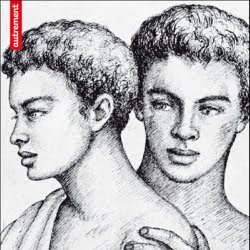
Baudry's 'Arcadie' Magazine
Arcadie nonetheless survived and eventually reached ten thousand subscribers throughout France and perhaps three or four times as many readers. Baudry also sent free copies to politicians, magistrates, doctors, and clergymen, in hopes of changing their negative attitude toward homosexuality.
In 1957 Baudry founded a homophile association, Clespala (Club Littéraire et Scientifique des Pays Latins, or Literary and Scientific Club of the Latin Countries), often also called "Arcadie" for short, headquartered in Paris, first on the rue Béranger, then on the rue du Château-d'Eau from 1969. The club held weekend dances for members (overwhelmingly male) and sponsored occasional banquets, cultural activities, and conferences. Once a month, Baudry addressed those members present in the clubhouse with his "Word of the Month," a speech that some sarcastically called a "sermon" because of Baudry's preachiness.
Baudry once said: "I was a happy, well-adjusted homophile; in any case I had never been ... a complicated, tortured, traumatized, and anxious homosexual worried by the anathema of the Church, by the family or by my surroundings." He wanted other homosexuals to accept themselves in the same way and live happy, full, and productive lives.
Baudry eschewed political agitation and demonstrations for equal rights, because, as one Arcadian put it, "we [homosexuals] are a minority and always will be a minority. The only policy possible for us is to educate intelligent people ... They are the ones who, little by little, shape public opinion." By the late 1970s, this position seemed hopelessly outdated to the younger generation. France changed dramatically after the "May events" of 1968 and, as one of Baudry's critics commented, "Try talking about 'dignity' and 'morals' to the children of the barricades and of the permissive society!" French gay liberationists of the 1970s were left-wing radicals, who tried to advance their cause through anti-establishment rhetoric, provocative behavior, and clamorous street demonstrations, all anathema to Baudry. Gay liberationists returned his contempt, and (paraphrasing Karl Marx) declared that "Arcadie is the opium of the homosexuals."
In the 1970s, as homosexuality came into the open in France, Baudry (who was an eloquent speaker) appeared frequently on radio and television and gave numerous interviews to the press, but he declined to work with other gay groups.
In 1982, Baudry abruptly ceased publication of Arcadie, closed down Clespala, and retired with his life partner, Giuseppe Adamo (who had worked as barman in the club), to the latter's native village near Naples, Italy. He died there in 2018.


1969 – Andrew Cunanan (d.1997) was an American spree killer who murdered at least five people, including fashion designer Gianni Versace, during a three-month period in 1997, ending with his own suicide, at age 27.
At school, Cunanan was remembered as being bright and very talkative, testing with an I.Q. of 147. As a teenager, he developed a reputation as a prolific liar given to telling fantastic tales about his family and personal life. He was also adept at changing his appearance according to what he felt was most attractive at a given moment.
After dropping out of college, he settled in the Castro District of San Francisco. While there, he frequented high-class gay bars and prostituted himself to wealthy older men.
When Cunanan was 19, his mother learned of Cunanan's homosexuality. During an ensuing argument, he threw her against a wall, dislocating her shoulder.
Before the murders, Cunanan was involved in petty theft and drug dealing.
Friends in San Diego, where he lived prior to the spree, felt he had some sort of break down after being rejected by his lover and his best friend. His friends attended an extravagant going away party for him when he said he was moving to San Francisco. He didn't go to San Francisco, though. He bought a one-way ticket to Minneapolis, where he stayed with a former lover, David Madson, 33. He arranged a fling with an old friend, Jeffrey Trail.
His friend Jeffrey Trail was his first murder in a three-month killing spree beginning April 27, 1997, in Minneapolis, Minnesota. Trail's body, with his head bashed in, was found wrapped in a rug in Madson's loft on April 29th. The second victim, architect David Madson, was killed May 2, 1997. His body, with a single shot to the head, was found four days later about 60 miles north of Minneapolis. Cunanan then drove to Chicago to kill Lee Miglin, 72, a real-estate developer, with a saw blade and pruning shears on May 4. The fourth victim, William Reese, 45, a cemetery caretaker, was killed for his car on May 9, 1997. Reese was killed by a single shot to the head with a .40-caliber Taurus. Cunanan then hid in Miami Beach, Florida, for months before the fifth murder. July 15, 1997, Andrew Cunanan, the 27-year-old multi-murderer, shot and killed Gianni Versace on his front steps in Miami Beach, Florida, U.S as he was returning home after a morning walk.
On July 23, 1997, eight days after murdering Versace, Cunanan shot himself in the mouth in the upstairs bedroom of a Miami houseboat. He used the same gun he had used to commit the other murders, a Taurus PT100 semi-automatic pistol in .40 S&W caliber, which had been stolen from the first victim, Jeff Trail.
His motivations remain a mystery. Various theories include jealousy for Versace's role as a "gay icon", as well as necessity and opportunity in some of the other murders.Cunanan was portrayed by Shane Perdue in the film The Versace Murder (1998), Jonathan Trent in the film Murder in Fashion (2009), Luke Morrison in the television film House of Versace (2013), and Darren Criss in The Assassination of Gianni Versace (2018), the second season of the television series American Crime Story.

2001 – The Canadian Human Rights tribunal rules in favor of prisons respecting sex reassignment.


4 notes
·
View notes